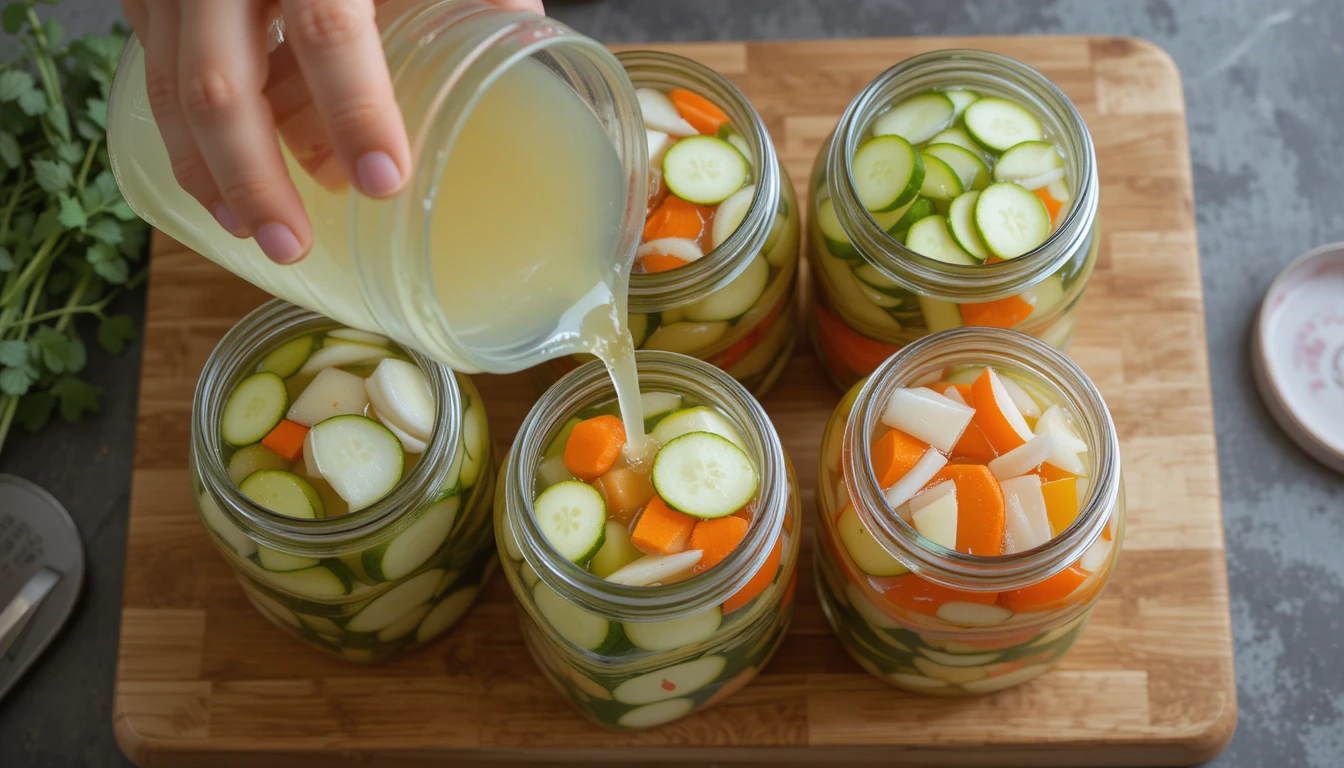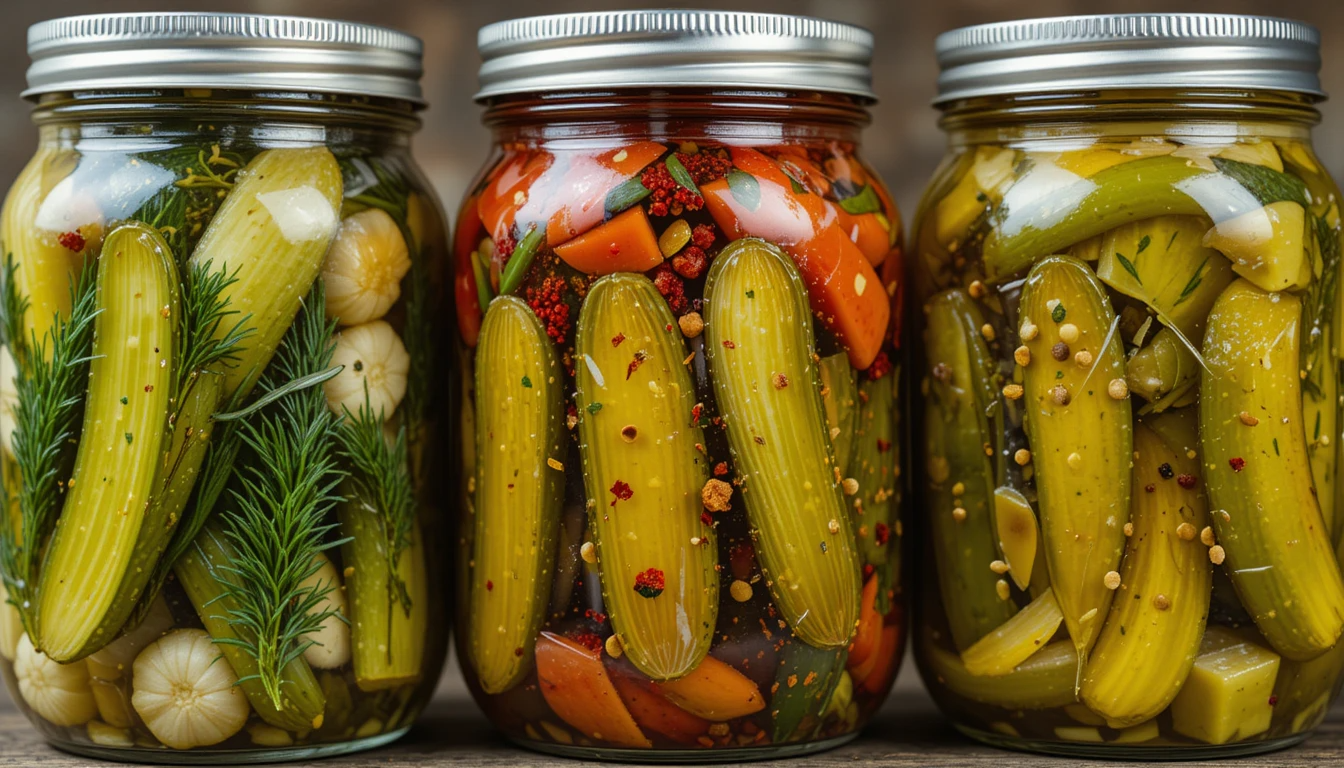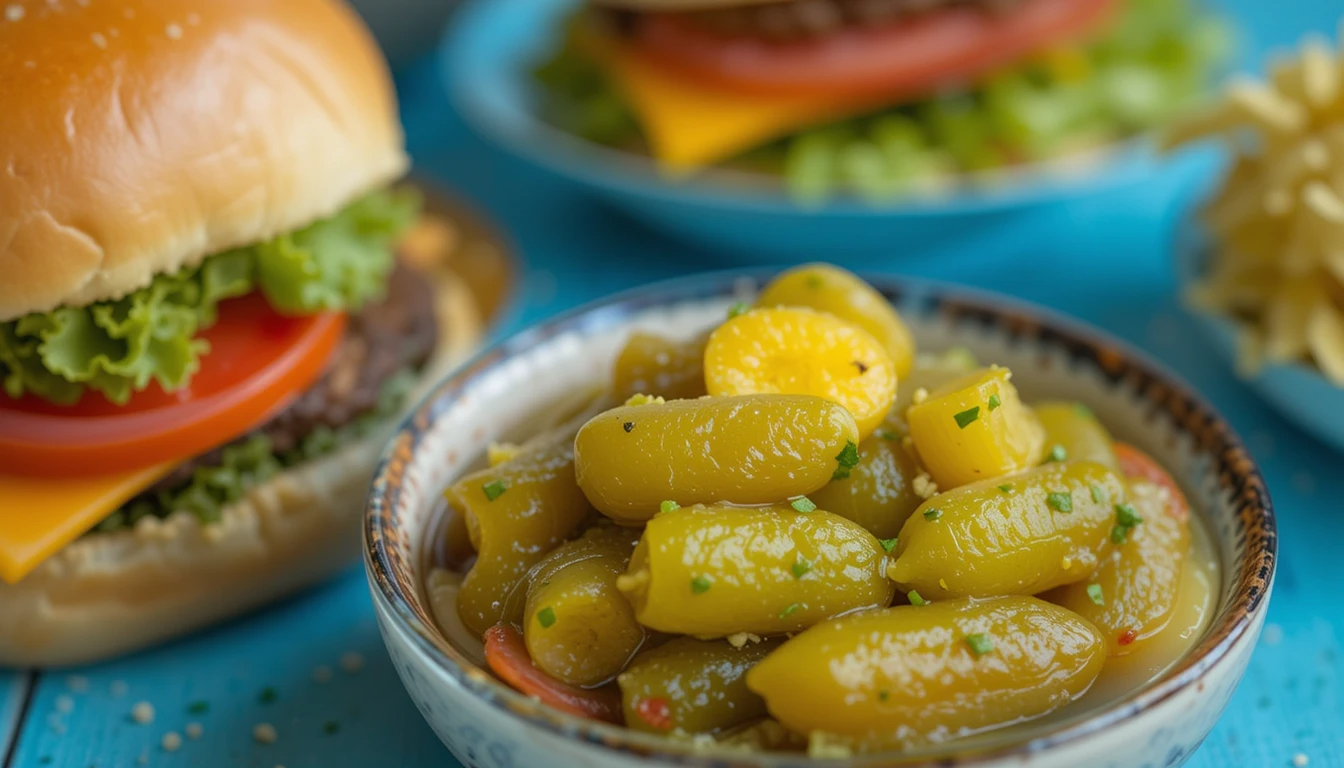What Are Quick Pickles?
Quick pickles, also called refrigerator pickles, are vegetables soaked in a simple brine of vinegar, water, salt, and sometimes sugar. Unlike fermented pickles that take weeks, this method is all about speed and fresh flavor. You can quick-pickle cucumbers, onions, beans, or even fruits like grapes and watermelon rind. They’re tangy, crunchy, and customizable with herbs or spices. The best part? You don’t need special equipment—just a jar, brine, and your favorite veggies.

Quick Pickle Recipe Summary
Making quick pickles is simple, fast, and requires no special equipment. Start by choosing fresh vegetables like cucumbers, onions, carrots, or radishes. Wash and slice them evenly so they pickle at the same rate.
Next, prepare the brine: combine vinegar (at least 5% acidity), water, salt, and sugar in a pot. Heat just enough to dissolve the salt and sugar—don’t overboil. Add optional flavorings like garlic, dill, mustard seeds, peppercorns, or chili flakes for extra taste.
Pack the vegetables tightly into clean jars and pour the hot brine over them, ensuring all pieces are fully submerged. Seal the jars with lids and let them cool at room temperature for a bit.
Finally, refrigerate your refrigerator pickles. They’ll be flavorful in just a few hours but taste best after 24 hours. Enjoy them within 1–2 weeks for maximum crunch and freshness.
That’s it—you’ve got crisp, tangy, homemade quick pickles ready to brighten sandwiches, salads, burgers, or snacks!
Ingredients You’ll Need To Make Quick Pickle
- 2 cups fresh vegetables (cucumbers, carrots, radishes, onions, or green beans)
- 1 cup vinegar (white, apple cider, or rice vinegar — 5% acidity)
- 1 cup water
- 1 tablespoon pickling salt (or kosher salt)
- 1 tablespoon sugar (optional, for balance)
- 2 cloves garlic (peeled, optional for flavor)
- 1 teaspoon mustard seeds (optional)
- 1 teaspoon black peppercorns (optional)
- 1–2 sprigs fresh dill (optional, for classic flavor)
- Pinch of red pepper flakes (optional, for heat)
The Quick Pickle Formula (Base Brine Recipe)
At the heart of every quick pickle recipe is a simple brine. This mixture of vinegar, water, salt, and sometimes sugar is what gives refrigerator pickles their signature flavor. The standard quick pickling ratio is easy to remember: 1 cup vinegar, 1 cup water, 1 tablespoon salt, and 1 tablespoon sugar. This balance ensures tangy, crisp vegetables without being overly sour or salty.
To prepare, combine the water, vinegar, salt, and sugar in a small pot. Heat just enough to dissolve the salt and sugar—no need for a long boil. Once cooled slightly, pour the brine over your prepared vegetables in a clean jar. Be sure the veggies are fully submerged for the best results.
The beauty of this quick pickle brine is how customizable it is. Want spicy pickles? Add red pepper flakes or jalapeños. Craving classic dill pickles? Toss in fresh dill and garlic cloves. You can even swap vinegars—apple cider for sweetness, rice vinegar for a lighter finish, or white vinegar for sharpness.
With this simple formula, you’ll master how to quick-pickle just about anything—turning ordinary produce into crunchy, flavorful pickles in no time.
Step-by-Step – How to Quick Pickle Any Vegetable
Learning how to quick-pickle is simple once you know the steps. Follow this easy quick pickling method and you’ll have crisp, tangy vegetables ready to enjoy in just a few hours.

Step 1: Choose and Prepare Vegetables
Start with fresh produce—cucumbers, onions, carrots, radishes, green beans, or even fruits like grapes. Wash thoroughly, then slice or cut into shapes you prefer. Thin slices pickle faster, while larger pieces keep a firmer crunch.
Step 2: Pack the Jars
Place your vegetables in clean glass jars. Add flavor boosters such as garlic, dill, mustard seeds, or peppercorns. Layer them for both flavor and appearance.
Step 3: Make the Brine
Use the quick pickle brine formula: equal parts vinegar and water, plus salt and sugar. Heat gently until dissolved, then let it cool slightly.
Step 4: Pour and Submerge
Pour the warm brine over your vegetables until fully covered. This step is key for crisp, flavorful refrigerator pickles.
Step 5: Seal and Chill
Close the jars with lids and place them in the refrigerator. Most quick pickles are ready in as little as 2–4 hours, though they taste even better after a full day.
Step 6: Enjoy and Store
Your homemade pickles can last up to two weeks in the fridge. Use them on sandwiches, tacos, salads, or as a crunchy snack.
With this step-by-step quick pickle recipe, you can transform almost any vegetable into a tangy treat—no canning required.
Best Vegetables & Fruits for Quick Pickling
One of the best things about a quick pickle recipe is how versatile it is. You’re not limited to cucumbers—almost any fresh produce can be transformed into crunchy, tangy refrigerator pickles with just a simple brine.
Classic Vegetables
- Cucumbers – The star of pickling. Thinly sliced cucumbers absorb brine quickly, giving you that refreshing crunch we all love in pickles.
- Onions – Quick pickled onions turn vibrant pink and add a tangy bite to tacos, burgers, or salads.
- Carrots – Sweet, crunchy, and perfect for snacking or adding to stir-fries.
- Green Beans – Crisp and slightly salty, they’re great as a side or cocktail garnish.
- Radishes – Their peppery flavor softens beautifully with pickling.
Creative Options
- Cauliflower – Break into florets for a crunchy, colorful snack.
- Zucchini – Mild in flavor but takes on brine and spices beautifully.
- Cherry Tomatoes – Bursting with tangy flavor, perfect for antipasto or pasta salads.
Unexpected Fruits
- Watermelon Rind – A zero-waste favorite, turning scraps into sweet-tangy pickles.
- Apples or Pears – Add cinnamon or cloves for a sweet-spiced twist.
- Grapes – Juicy, sweet, and surprisingly addictive when pickled.
The beauty of quick pickling is experimenting with flavors and textures. Whether you stick to classics like cucumbers or explore creative options like pickled fruit, you’ll always end up with something unique. With just a few jars and a simple brine, you can enjoy crisp, flavorful pickles tailored to your taste.
Flavor Variations to Try
One of the joys of a quick pickle recipe is how customizable it is. With just a few tweaks to your brine and spices, you can create endless quick pickle variations to match your mood or meal.
- Dill Garlic Pickles – A classic combination. Add fresh dill, garlic cloves, and black peppercorns for crisp, savory flavor. Perfect with sandwiches or burgers.
- Spicy Pickles – Toss in red pepper flakes, sliced jalapeños, or chili powder for heat. These are great for tacos, wraps, or a bold snack.
- Sweet Pickles – Add more sugar or a drizzle of honey for balance. Sweet pickles pair well with cheese boards or salty fried foods.
- Asian-Inspired Pickles – Use rice vinegar, ginger, sesame seeds, or soy sauce for a tangy twist. Delicious with noodles and stir-fries.
- Herb-Infused Pickles – Try rosemary, thyme, or basil for fragrant flavors.
These flavored quick pickles prove that pickling is more than cucumbers. From tangy dill to spicy-sweet blends, every jar can be tailored to your taste. Don’t be afraid to experiment—the possibilities are endless!
Storage, Shelf-Life, and Safety Tips
One of the biggest questions people ask about a quick pickle recipe is: How long do quick pickles last? Since these are refrigerator pickles and not canned or fermented, they have a shorter shelf life. On average, most quick pickles stay fresh for up to two weeks when properly stored in the fridge. Some may last a little longer, but they are best enjoyed while crisp and flavorful.
Storage Tips
- Use clean jars – Always start with washed and dried glass jars to avoid unwanted bacteria.
- Keep veggies submerged – Make sure your vegetables are fully covered in brine; exposure to air can lead to spoilage.
- Seal tightly – A snug lid helps keep your pickles crunchy and prevents odors from the fridge mixing in.
- Refrigerate immediately – Never leave your jars out on the counter for long periods.
Shelf-Life Signs
- Fresh refrigerator pickles should look bright and smell tangy.
- If you notice cloudiness, slime, or an off smell, it’s best to discard the batch.
- Mushy or discolored vegetables are another sign your pickles have gone bad.
Safety Reminders
- Don’t reuse brine more than once, as it may lose acidity and safety.
- Stick to vinegar with at least 5% acidity for proper preservation.
- When in doubt, throw it out—it’s better to make a fresh jar than risk it.
With these simple storage and safety tips, your quick pickles will stay crisp, tasty, and safe to eat every time.
Quick Pickles vs. Traditional Pickles
If you’ve ever wondered about the difference between quick pickles and traditional pickles, you’re not alone. Both methods transform vegetables into tangy, flavorful snacks, but the process and results are quite different.
Quick Pickles (Refrigerator Pickles)
Quick pickling is all about speed and simplicity. Vegetables are soaked in a vinegar-based brine, stored in the refrigerator, and ready to eat within hours or days. These refrigerator pickles keep their bright color and crisp texture, but they don’t last as long—usually about two weeks. Quick pickling is ideal if you want fresh flavor without waiting.
Traditional Pickles (Fermented Pickles)
Traditional pickling, often called fermentation, is a slower method. Instead of vinegar, vegetables are submerged in a salty brine, where natural bacteria create lactic acid. This process takes weeks but results in deeper flavors and a natural tang. Fermented pickles can last for months if properly canned and stored.
Key Differences
- Time – Quick pickles: hours to days. Traditional pickles: weeks to months.
- Flavor – Quick pickles: bright, fresh, and customizable. Traditional pickles: bold, sour, and complex.
- Shelf Life – Quick pickles: up to 2 weeks in the fridge. Fermented pickles: months in a pantry if sealed.
- Process – Quick pickling uses vinegar; fermentation uses salt and bacteria.
In short, quick pickles are perfect for instant flavor and variety, while traditional pickles are great for long-term storage and deeper taste. Both have their place in the kitchen—it simply depends on your time and preference.

Common Mistakes to Avoid
Even though a quick pickle recipe is simple, a few small mistakes can affect the flavor, texture, or safety of your pickles. Here are the most common errors people make when learning how to quick-pickle—and how you can avoid them.
1. Using the Wrong Vinegar
Not all vinegars are created equal. Stick with vinegars that have at least 5% acidity, such as white, apple cider, or rice vinegar. Flavored or diluted vinegars may not preserve vegetables properly.
2. Skipping the Salt
Salt isn’t just for taste—it’s key for crispness and preservation. Using too little can make your refrigerator pickles bland or spoil faster. Use pickling salt or kosher salt for the best results.
3. Overheating or Over-Boiling the Brine
Heating the brine helps dissolve salt and sugar, but boiling it too long can dull flavors. A quick simmer is all you need.
4. Not Submerging Vegetables Fully
Air exposure leads to soggy or spoiled pickles. Always make sure your veggies are completely covered by the brine.
5. Expecting Long Shelf Life
Remember, quick pickles are meant to be enjoyed fresh. They usually last up to two weeks in the fridge. Don’t expect them to stay good for months like traditional fermented pickles.
6. Ignoring Jar Cleanliness
Using dirty jars or utensils can introduce bacteria. Always wash and dry jars before filling.
By avoiding these common quick pickling mistakes, you’ll enjoy crunchy, flavorful, and safe pickles every time.
Quick Pickle FAQ
When trying a quick pickle recipe for the first time, it’s normal to have questions. Here are answers to the most common ones so you can master how to quick-pickle with confidence.
1. How soon can I eat quick pickles?
Most refrigerator pickles are tasty after 2–4 hours, but for the best flavor, wait 24 hours. This gives the brine time to fully soak into the vegetables.
2. How long do quick pickles last?
Quick pickles typically stay fresh for up to two weeks in the fridge. They are best eaten while crisp and bright.
3. Can I reuse pickle brine?
It’s not recommended. Reusing brine can weaken acidity and may lead to unsafe pickles. Instead, make a fresh batch each time—it only takes minutes.
4. Do I need to sterilize jars?
Unlike traditional canning, you don’t need to sterilize jars for quick pickling. Just wash jars and lids thoroughly with hot, soapy water and dry them well.
5. Can I make sugar-free or low-salt quick pickles?
Yes! You can skip sugar or reduce salt slightly, though keep in mind that both help with flavor and preservation. Always maintain enough vinegar for safety.
6. What vegetables can I quick pickle?
From cucumbers and onions to carrots, radishes, and even fruits like grapes or watermelon rind, the options are endless.
Can I quick pickle without vinegar?
No, vinegar is essential for a proper quick pickle recipe. If you want vinegar-free pickles, you’ll need to try fermentation instead, which is a slower process.
8. Why are my quick pickles soft instead of crunchy?
Soft pickles usually mean the vegetables weren’t fresh, or they weren’t fully submerged in brine. For extra crunch, use very fresh produce and refrigerate immediately.
9. Can I quick pickle fruits?
Yes! Apples, grapes, peaches, and even watermelon rinds can be turned into tangy, sweet quick pickles. They pair well with cheese boards or grilled meats.
10. What type of salt is best for quick pickles?
Use pickling salt or kosher salt. Table salt often has additives that can make your brine cloudy or affect flavor.
11. Do quick pickles taste the same as store-bought pickles?
Not exactly. Refrigerator pickles have a fresher, lighter taste compared to the bold, fermented flavor of store-bought jars. Many people actually prefer the crispness of homemade.
12. Can I add oil to my quick pickle brine?
It’s best to avoid adding oil, as it can spoil quickly and affect preservation. Stick with vinegar, salt, and seasonings.
13. Are quick pickles healthy?
Yes! They’re low in calories, contain probiotics if lightly fermented, and are packed with nutrients from fresh vegetables. Just keep an eye on the salt content.

